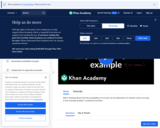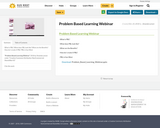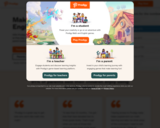
The addition rule for probability is explained using Venn Diagrams. [Probability playlist: Lesson 3 of 29]
- Subject:
- Math
- Material Type:
- Activity/Lab
- Provider:
- Khan Academy
- Provider Set:
- Khan Academy
- Author:
- Salman Khan
- Date Added:
- 10/10/2018

The addition rule for probability is explained using Venn Diagrams. [Probability playlist: Lesson 3 of 29]

This lesson introduces basic probability. [Probability playlist: Lesson 1 of 29]

This lesson is a birthday problem that determines the probability that at least 2 people in a room of 30 share the same birthday. [Probability playlist: Lesson 17 of 29]

This lesson presents an example of dependent probability. [Probability playlist: Lesson 10 of 29]

This lesson presents an example of dependent probability. [Probability playlist: Lesson 11 of 29]

Today we’re going to begin our discussion of probability. We’ll talk about how the addition (OR) rule, the multiplication (AND) rule, and conditional probabilities help us figure out the likelihood of sequences of events happening - from optimizing your chances of having a great night out with friends to seeing Cole Sprouse at IHop!

Today we're going to introduce bayesian statistics and discuss how this new approach to statistics has revolutionized the field from artificial intelligence and clinical trials to how your computer filters spam! We'll also discuss the Law of Large Numbers and how we can use simulations to help us better understand the "rules" of our data, even if we don't know the equations that define those rules.

This lesson begins a six part series of basic probabiltiy using module examples. [Probability playlist: Lesson 4 of 29]

This lesson demonstrates probability using combinations and shows the probability of getting exatly 3 heads in 8 flips of a fair coin. [Probability playlist: Lesson 14 of 29]

This lesson is another demonstration of probability and combinations to determine the probability of making at least 3 out of 5 basketball free throws. [Probability playlist: Lesson 15 of 29]

This lesson uses playing cards and Venn Diagrams to explain the idea of probability [Probability playlist: Lesson 2 of 29]

This lesson shows how an insurance company uses probability to determine a person's chances of dying. [Probability playlist: Lesson 18 of 29]

What is PBL?
What does PBL look like?
What are the Benefits?
How do I create A PBL?
PBL in Sun West

Students apply what they have learned about the engineering design process to a real-life problem that affects them and/or their school. They chose a problem as a group, and then follow the engineering design process to come up with and test their design solution. This activity teaches students how to use the engineering design process while improving something in the school environment that matters to them. By performing each step of the design process, students can experience what it is like to be an engineer.

Students are introduced to a systematic procedure for solving problems through a demonstration and then the application of the method to an everyday activity. The unit project is introduced to provide relevance to subsequent lessons.

Students use a hundred board to eliminate numbers after reading each clue. Students must apply their knowledge of even-odd, multiples and place value to successfully eliminate numbers until the solution is revealed.

These logic number puzzles help students develop strong number sense as they work, clue by clue, to identify the digits of the missing number. The mixed-skills clues incorporate even-odd, less than-greater than, operations (sum, difference), multiples of 5 and 10, geometric terms (octagaon, pentagon, hexagon, quadrilateral, trapezoid, parallelogram), money (quarters, nickels) and measurement (cup, pint, quart, gallon). Students must squeeze every bit of knowledge from each clue to eliminate possible digits until they finally identify the missing digits.

From The University of Waterloo:
"Many instructors in engineering, math and science have students solve “problems”. But are their students solving true problems or mere exercises? The former stresses critical thinking and decision-making skills whereas the latter requires only the application of previously learned procedures. True problem solving is the process of applying a method – not known in advance – to a problem that is subject to a specific set of conditions and that the problem solver has not seen before, in order to obtain a satisfactory solution."
Details are provided on the principles of problem-solving as well as each step of the process outlined below:
Define the Problem
Think About it
Plan a Solution
Carry Out the Plan
Look Back

Students build a world of their own by answering curriculum aligned questions covering thousands of skill strands. Reading, writing, rhyming and phonetics are included.
Educators get free full access. Parents can work collaboratively with their child's teacher for access or purchase home memberships.

Join over 20 million students, teachers, and parents using our free, curriculum-aligned math game for Grades 1 - 8.
Prodigy is a free, Pokemon-style math game that has been proven to improve student scores and confidence! It is aligned to the Ontario curriculum for grades 1-6, and features content from each of the five major strands.
Prodigy was designed with three primary goals in mind:
1. To create deep engagement so students double their math practice time at home.
2. To equip teachers with reports and assessment tools to inform their instruction.
3. To provide curriculum aligned content for free, regardless of a student’s demographic.
Teachers can create assignments and assessments, align them curriculum, and check in on progress. The program automatically adapts to students who are struggling or excelling, but teacher's also have the option to override grade levels to adapt and modify for individual students. Parents can connect and see what their child is working on, and students can access the program from any computer or tablet.
**NOTE - For FREE summer or at home access, ask your child's teacher to create an account!